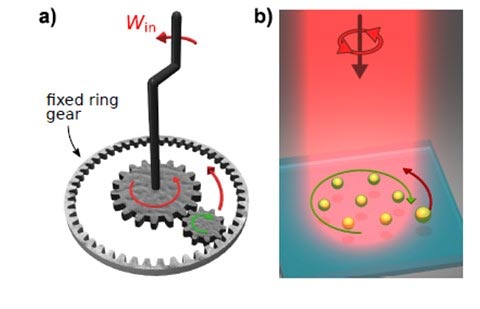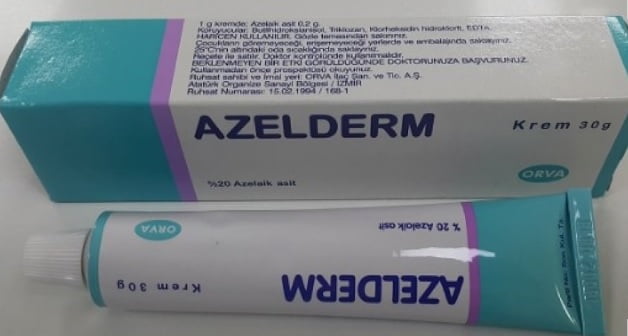Based on optical matter, new machines could be used to move and manipulate tiny particles.
Researchers have developed a tiny new machine that converts laser light into work. These optically powered machines assemble themselves and can be used to nano-scale manipulation of tiny cargo for applications like nanofluidics and particle sorting.
“Our work addresses a longstanding goal in nanoscience to develop self-organizing nanoscale machines that can perform work in conventional environments such as room temperature liquids,” said Norbert F. Scherer, head of the research team at the University of Chicago.

The researchers developed an optical matter machine that works similarly to a mechanical machine. When a gear is turned, a smaller locking wheel turns in the opposite direction (a). The optical matter machine (b) uses circularly polarized light to create an array of nanoparticles that, by rotating in the optical field, acts like the larger gear. As a result, a probe particle – analogous to the second smaller gear wheel – circles the nanoparticle array in the opposite direction. Photo credit: Norbert F. Scherer, University of Chicago
Scherer and colleagues describe the new nanomachines in Optica, The Journal of the Optical Society (OSA) for high impact research. The machines are based on a type of matter known as optical matter, in which metal nanoparticles are held together by light, rather than the chemical bonds that hold the atoms together that make up typical matter.
“Both the energy for assembling the machine and the power with which it works come from the light,” said Scherer. “As soon as the laser light is introduced into a solution with nanoparticles, the entire process runs automatically. Although there is no need for the user to actively control or steer the result, it can easily be done to adapt the machines for different applications. ”
Create optical matter
In optical matter, a laser light field creates interactions between metal nanoparticles that are much smaller than the wavelength of light. These interactions cause the particles to assemble into ordered arrays. This is a similar principle to optical capture, where light is used to hold and manipulate particles, biological molecules, and cells.
This video shows a simulation of a gear with seven particles of optical matter. The rotating and orbital movement of the field (blue) that is scattered by the nanoparticles (yellow) when circularly polarized light falls on the nanoparticles can be seen. The rotation of the scattered light (blue) creates the counterclockwise movement of a nanoparticle probe that would enter the optical trap near the gear. The probe particle (not shown here) then orbits while being nudged in a similar manner by the movement of the movement of the scattered light (blue). The collective rotation of the entire gear is not apparent as it occurs on much longer time scales than the femtosecond time scale movement of the light shown here. Photo credit: Norbert F. Scherer, University of Chicago
In previous work, the researchers discovered that optical matter, when exposed to circularly polarized light, rotates as a rigid body in the opposite direction to the polarization rotation. In other words, when the incident light rotates in one direction, the optical array of matter reacts by rotating the other. This is a manifestation of the “negative torque”. The researchers speculated that a machine could be developed based on this new phenomenon.
In the new work, the researchers developed an optical matter machine that works similar to a mechanical machine based on interlocking gears. In such machines, when a gear is turned, a smaller locking wheel turns in the opposite direction. The optical matter machine uses circularly polarized light from a laser to create an array of nanoparticles that acts like the larger gear by rotating in the optical field. This “gear for optical matter” converts the circularly polarized light into an orbital or angular momentum that influences a nearby probe particle to orbit the nanoparticle array (the gear) in the opposite direction.
Determine efficiency
The researchers made two machines based on this design, using laser light with a wavelength of 600 nanometers and chip nanoparticles only 150 nanometers in diameter in water. They found that using an eight nanoparticle gear was a more efficient machine than using a seven nanoparticle gear, suggesting that the efficiency of the machine can be changed by building different gears.
“We believe that with further refinement, what we have demonstrated will be useful in nanofluidics and particle sorting,” said John Parker, graduate student and lead author. “Our simulations show that a much larger machine made of many more particles can exert more power on the probe. This is one aspect of the refinement that we expect to pursue. ”
The researchers are now experimenting with making machines with many more particles or with particles made of different materials. The practicability of the machine could also be improved by creating structured gears in which the nanoparticles are immobile. This would allow the ability to optically address and combine multiple gears to make a more complex machine.
Reference: “A machine for optical matter: angular momentum conversion through collective modes in optically bound nanoparticle arrays” by John Parker, Curtis Peterson, Yuval Yifat, Stuart Rice, Zijie Yan, Stephen Gray and Norbert Scherer, October 8, 2020, Optica 7th
DOI: 10.1364 / OPTICA.396147



